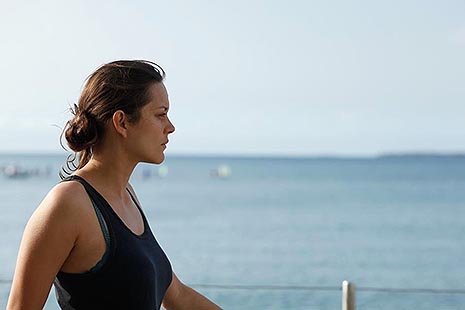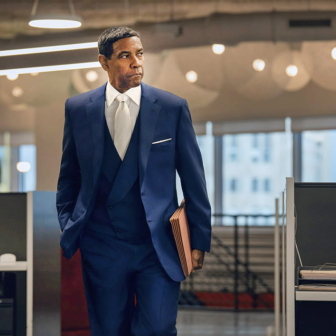Jacques Audiard’s Rust and Bone (De Rouille et d’Os) has been the French film of the season. It has been saluted especially for Marion Cotillard’s compelling performance as an amputee who must find her way back into life after losing both legs. The story’s initial catastrophe is the violent breaking up of a shoddily built platform at a marina near Antibes, where beautiful girls in diving suits conduct performances by trained killer whales; Cotillard’s Stéphanie, called Stéph, has been one of them. At the beginning the animals, computer-generated or not, are a great spectacle, and their splendour matters to the story; the orca that caused Stéphanie’s maiming wasn’t enraged, only playing himself. Later in the film, crippled, she stands outside the glass wall of the giant tank and reprises the training gestures, as a huge marine beast responds. It’s a very powerful moment of cinematic ballet, rescued from sentimentality by its brevity and silence.
The film’s account of Stéphanie’s rehabilitation – first with the stumps of her limbs, then with the kinds of artificial legs made familiar in images from the Paralympics – is cunningly and convincingly done; here digital devices yield rewards in drama. The harder psychological journey is followed in Cotillard’s extraordinary face, scrubbed clean of makeup (or apparently so); pale, clear-skinned, with bruised eyes, she looks nothing like her version of Edith Piaf. She creates the rocky, halting ride from deep depression and indifference to engagement in an uneasy relationship, and through that into another kind of life.
The double-centred narrative begins with Alain, called Ali (Matthias Schoenaerts), and his five-year-old son Sam (Armand Verdure); they’re in a train, travelling away from problems, which are never quite unfolded, with Sam’s mother. The child is hungry; Ali scrounges food. It’s clear that his parenting skills are somewhat underdeveloped, and that he’s hardly grownup himself. His relationship with Stéphanie begins randomly in a dance hall; later, she rings him on impulse, and sets off the remarkable sequence in which she manages a swim in the sea. She also instigates sex, letting Ali know that she wants to make sure of her continued capabilities; he obliges – no problem, since his love-life has evidently been, up to now, a matter of one-night stands.
On that score, she calls him to order, insisting that if it’s going to go on happening for them she wants some respect; they’re not going to be, she says, “like animals.” The film’s way of following their paths to adulthood is cautious, discreet, glancing in other directions. Ali must also get real with his battling, down-to-earth sister Anna (Corinne Masiero), to whom he has come for shelter and a family place for Sam. Anna works as a cashier; blundering around, Ali inadvertently gets her sacked. While the film is in no way parading politics, we are made aware of precarious lives; no one in this milieu has a secure job, housing or professional status. Ali bounces between unsteady work as a security watchman and bare-knuckle public fighting, with gambling attached (there’s a long list of credits for the stunts). Stéphanie watches with rising fascination, and we fear for the child – who in time (getting the audience properly below the belt) becomes the centre of the story.
Melodrama? On plot level it is: the family surrounds, the family is broken, the family is restored or re-made. But in the hands of Audiard and his co-writer Thomas Bidegain, Rust and Bone cuts loose from its genre and takes flight. They are assisted by a wonderful cinematographer, Stéphane Fontaine; and while this is no travelogue on the Côte d’Azur, his treatment of sunlight and water – flashing in here and there, blurring edges, permeating the locale and the movement of people around it – lightens the whole experience. So does the music of Alexandre Desplat, and the songs that belong in the milieu. The credits include a special thanks to Bruce Springsteen.
The arguments around the Kathryn Bigelow–Mark Boal thriller Zero Dark Thirty – now finishing its run, but still to be found in the corners of the suburban circuits – have been arguably more interesting than the film itself, agreeably gripping as it is. Those arguments were alive at the outset; I emerged much as I might from a late Ford western or a 1940s film noir – directed, say, by Nicholas Ray, and starring Humphrey Bogart – with the sense that this exercise was a lot of fun, giving the pleasure excited by sheer expertise, precision and coherence, truth to the appropriate conventions. But then, questions raise their heads. This is about a manhunt; the man must be found; he has committed mass murder, he struck a great blow against the whole United States, and so the nation, the victims and their families must be avenged. One particular very smart CIA operative, Maya (Jessica Chastain), figures that if Osama’s couriers can be tracked, his hideout will be identified and the troop of Navy SEALS can go in. She is one small woman in a cohort of powerful men, and before all’s done she has to get them to believe her. Behind the fiction, there has evidently been a female CIA officer something like this.
The casting is precise, for Chastain communicates not only a quick, nervy intelligence, but also the fragility of a professional absolutely wrapped up in her role. In the opening episode, when a supposed Afghani spy is subjected to “enhanced interrogation techniques” and then forced into a suffocating box, she is impassive, and quite merciless in the face of the man’s pleas. Later, over a meal, the same man, Ammar (Reda Kateb), helps her with a clue in the quest. The implication is that the experience of torture induced him to yield a piece of vital information. That connection has been vigorously denied. In another sequence, three of Maya’s male colleagues watch Obama insisting, on TV, that “we don’t do torture.” Her face remains blank; the viewer can map on to it what she will.
Through the first half of the movie she has a friend, a colleague played by Jennifer Ehle; as they share a hotel dinner, there’s a passage of actual human communication. Hasn’t she anyone close, no boyfriend around? These CIA career girls are in their thirties. Maya has time to say no, there’s nobody, before a bomb goes off and the hotel dining room is destroyed. Not much later another bomb goes off at the base camp, and Maya’s friend is killed; from that point, her obsession is even more intense. We see her pursuing clues from old footage on her computer, looking at detainees and interrogators, hearing fragments of talk among the men. There’s a meeting around a long table, where she is patronised by the Agency’s director (James Gandolfini). She has to fight for the validity of imagination and intuition, as well as procedural work and research. When it is known that bin Laden is not in some remote mountain hideout, but in a large compound in Abbottabad, she wins. In an extraordinary twenty-five-minute sequence, filmed for maximal tension in the foggy green light allowed by night-vision goggles, the SEALS invade, pursue the quarry from room to room; we get glimpses of women and children, likely to be collateral victims; and then, for what it’s worth, America’s arch enemy meets his fate. We see very little of him, alive or dead. When the body bag is unzipped, Maya identifies the corpse with no more than a nod.
Then, small and alone, she’s on her way back to Washington, a solitary passenger in a huge USAF transport. Critics have deplored the final moment, in which tears roll down her face. She has been frozen in her role, to the point of something like autism; then there’s a last-minute breakthrough into quite helpless humanity. Take it as you will; I thought it could be read as a recognition of the ultimate uselessness of the entire massive, decade-long project.
What’s been surprising, in the array of public responses and in discussion at large, is the number of those who’ve read the whole film as somehow constituting pro-American propaganda. Among those, locally, have been the excellent journalists Antony Loewenstein and Waleed Aly; each has condemned Zero Dark Thirty as a defence of US strategies and tactics in the “war on terror.” In general I share the politics of both these commentators, but I can’t see their arguments here. This film was never propaganda; American interests and projects are not being promoted or defended – you could in fact argue the contrary. Its purposes are those of entertainment, and as such, on one viewing it works: a genre thriller, and like The Hurt Locker, from the same team, a tight weave of history and fiction. If it were entirely fiction, there’d be no argument. But in concocting it, we’re told that Mark Boal found his way into much classified information. Given that, I’d have felt kinder to the outcome had it been made with attention to that information – in short, as unvarnished documentary. From the very first moments – a dark screen, with sound evidently composed of actual voices coming out of the twin towers as they exploded and fell – history is identified and dated. Once named, history should be told and probed; analysis is called for. The worry is not about propaganda, but about a project in which the makers call on recent lived actuality, and then claim the privilege of fiction, trying to have it both ways. In for a penny, in for a pound. •





